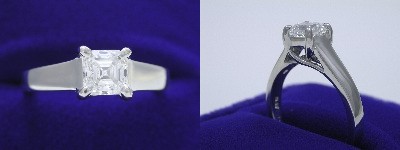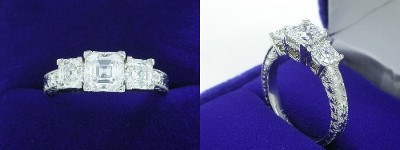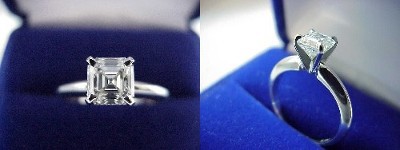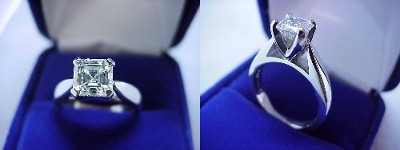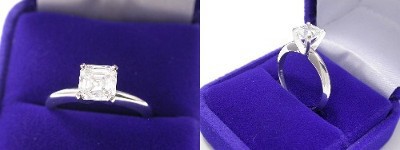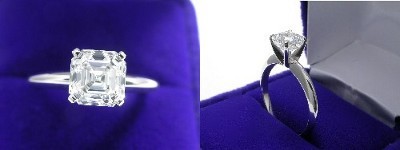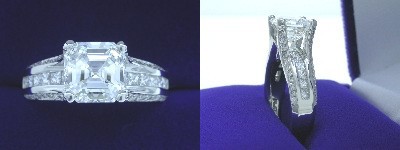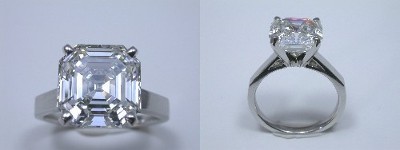In 1902, Asscher Diamond Co. patented a rectilinear diamond cut. Developed by Joseph Asscher, the squarish step cut’s deeply cut corners give it an almost octagonal outline. It features a small table, high crown, broad step facets, deep pavilion and square culet. The Asscher cut was inspired by the table cuts of the Renaissance. However, it was a big departure from the brilliant cuts that dominated the 1800s and was a forerunner of the standard emerald cut. The Asscher cut was developed prior to 1910, when the rotary diamond saw revolutionized modern diamond cutting.
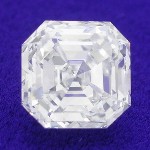 The Asscher cut is a square cut characterized by a smaller table and larger step facet than an emerald cut. It features dramatic, cut corners. It usually has a high crown and a deeper pavilion than today’s emerald cuts. Because of its high crown and small table, the Asscher cut has more light and fire than an emerald cut.
The Asscher cut is a square cut characterized by a smaller table and larger step facet than an emerald cut. It features dramatic, cut corners. It usually has a high crown and a deeper pavilion than today’s emerald cuts. Because of its high crown and small table, the Asscher cut has more light and fire than an emerald cut.
While square emerald cuts and Asscher cuts are similar in facet patterns, Asschers tend to have a depth of 60% or greater and a smaller table. Asschers typically have the following characteristics:
- High crown
- Small table
- Deep and slightly bulging pavilion
- Wide cut corners
- Wide windmill reflection
- House of mirrors (concentric square patterns)
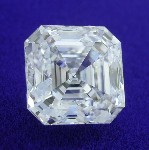 The Royal Asscher Diamond is a branded name version of the Asscher cut diamond that is that is only cut by one company and only distributed by one wholesaler in the United States. As a result, there is limited supply and you can expect to pay a premium for this special cut.
The Royal Asscher Diamond is a branded name version of the Asscher cut diamond that is that is only cut by one company and only distributed by one wholesaler in the United States. As a result, there is limited supply and you can expect to pay a premium for this special cut.
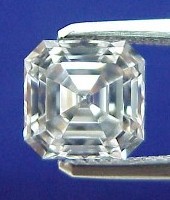 Estate and antique dealers seek Asscher Cuts to repair or replace older pieces of jewelry. Asscher Cuts were somewhat short in supply and high in demand, especially with the growing popularity of square-cut diamonds. Older cuts that have not been recut fetch a premium price. Each stone must be seen and evaluated individually; there is no standard pricing for this type of stone since most are unique. There are still some Asschers being cut today. Stone for stone, there is little difference in value between old Asscher and a newly cut one.
Estate and antique dealers seek Asscher Cuts to repair or replace older pieces of jewelry. Asscher Cuts were somewhat short in supply and high in demand, especially with the growing popularity of square-cut diamonds. Older cuts that have not been recut fetch a premium price. Each stone must be seen and evaluated individually; there is no standard pricing for this type of stone since most are unique. There are still some Asschers being cut today. Stone for stone, there is little difference in value between old Asscher and a newly cut one.
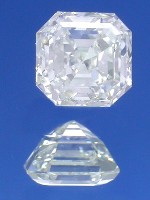 Advice: We recommend at least H color and VS2 clarity for Asscher cut diamonds. The most beautiful Asscher cut diamonds tend to have greater depth percentages and low table percentages. We like depth percentages in the 58-69% range and table percentages in the 50-65% range. There are beautiful Asschers with greater depths but few clients are willing to accept the small millimeter size that comes with greater depth. Likewise table percentages below 60% are exceptionally beautiful but often in short supply. Like all diamond shapes, picking the “best” Asscher means finding the right balance of beauty, size and price.
Advice: We recommend at least H color and VS2 clarity for Asscher cut diamonds. The most beautiful Asscher cut diamonds tend to have greater depth percentages and low table percentages. We like depth percentages in the 58-69% range and table percentages in the 50-65% range. There are beautiful Asschers with greater depths but few clients are willing to accept the small millimeter size that comes with greater depth. Likewise table percentages below 60% are exceptionally beautiful but often in short supply. Like all diamond shapes, picking the “best” Asscher means finding the right balance of beauty, size and price.
The following photos are only a sampling of Asscher cut diamond ring styles. Hundreds of mounting styles look great with Asscher cut diamonds so just email us a picture of the style you like and we can get you a price quote. You can also check out our Designer Gallery for pictures of mountings from some of our suppliers.


